现代英语词汇学概论最强版复习资料chapter1
- 格式:doc
- 大小:41.50 KB
- 文档页数:3
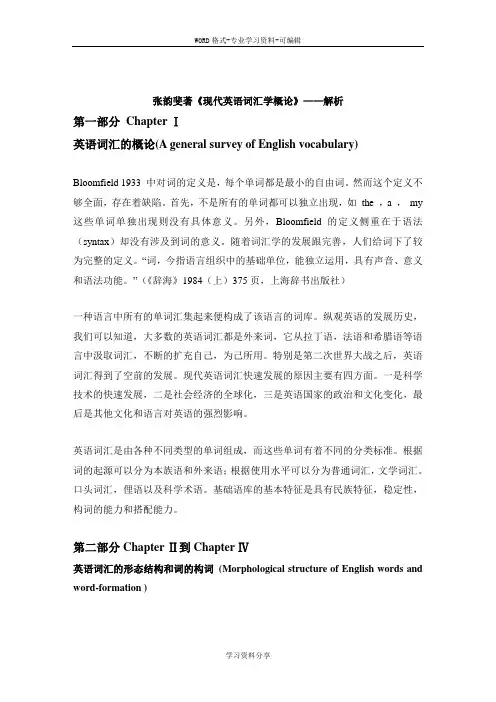
张韵斐著《现代英语词汇学概论》——解析第一部分Chapter Ⅰ英语词汇的概论(A general survey of English vocabulary)Bloomfield 1933 中对词的定义是,每个单词都是最小的自由词。
然而这个定义不够全面,存在着缺陷。
首先,不是所有的单词都可以独立出现,如the ,a ,my 这些单词单独出现则没有具体意义。
另外,Bloomfield的定义侧重在于语法(syntax)却没有涉及到词的意义。
随着词汇学的发展跟完善,人们给词下了较为完整的定义。
“词,今指语言组织中的基础单位,能独立运用,具有声音、意义和语法功能。
”(《辞海》1984(上)375页,上海辞书出版社)一种语言中所有的单词汇集起来便构成了该语言的词库。
纵观英语的发展历史,我们可以知道,大多数的英语词汇都是外来词,它从拉丁语,法语和希腊语等语言中汲取词汇,不断的扩充自己,为己所用。
特别是第二次世界大战之后,英语词汇得到了空前的发展。
现代英语词汇快速发展的原因主要有四方面。
一是科学技术的快速发展,二是社会经济的全球化,三是英语国家的政治和文化变化,最后是其他文化和语言对英语的强烈影响。
英语词汇是由各种不同类型的单词组成,而这些单词有着不同的分类标准。
根据词的起源可以分为本族语和外来语;根据使用水平可以分为普通词汇,文学词汇。
口头词汇,俚语以及科学术语。
基础语库的基本特征是具有民族特征,稳定性,构词的能力和搭配能力。
第二部分Chapter Ⅱ到Chapter Ⅳ英语词汇的形态结构和词的构词(Morphological structure of English words and word-formation )(一)词素(Morphemes)单词是有词素(morphemes)构成的。
词素即英语语言中有意义的最小单位,同时具有声音和意义。
单词可以有一个或一个以上的词素组成。
如:nation 是一个词素,national有nation+al 两个词素。
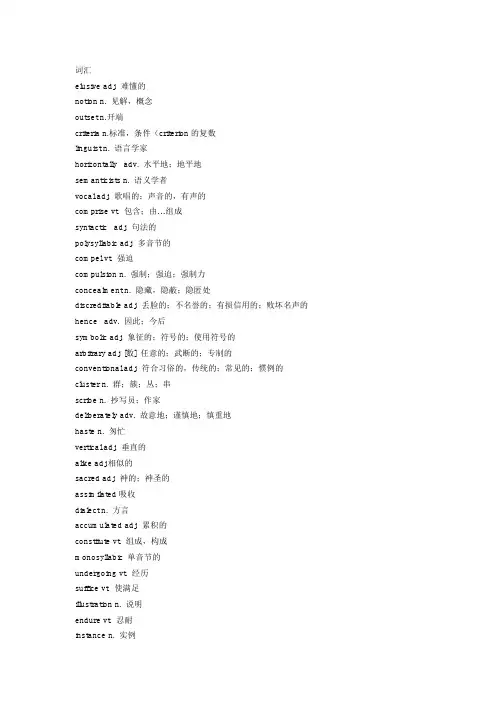
词汇elusive adj. 难懂的notion n. 见解,概念outset n.开端criteria n.标准,条件(criterion的复数linguist n. 语言学家horizontally adv. 水平地;地平地semanticists n. 语义学者vocal adj. 歌唱的;声音的,有声的comprise vt. 包含;由…组成syntactic adj. 句法的polysyllabic adj. 多音节的compel vt. 强迫compulsion n. 强制;强迫;强制力concealment n. 隐藏,隐蔽;隐匿处discreditable adj. 丢脸的;不名誉的;有损信用的;败坏名声的hence adv. 因此;今后symbolic adj. 象征的;符号的;使用符号的arbitrary adj. [数] 任意的;武断的;专制的conventional adj. 符合习俗的,传统的;常见的;惯例的cluster n. 群;簇;丛;串scribe n. 抄写员;作家deliberately adv. 故意地;谨慎地;慎重地haste n. 匆忙vertical adj. 垂直的alike adj.相似的sacred adj. 神的;神圣的assimilated 吸收dialect n. 方言accumulated adj. 累积的constitute vt. 组成,构成monosyllabic 单音节的undergoing vt. 经历suffice vt. 使满足illustration n. 说明endure vt. 忍耐instance n. 实例monosemous adj. 单义的mere adj. 仅仅的blunt adj. 钝的justify V 证明stylistically adv. 在文体上heterogeneity n. [生物] 异质性;[化学] 不均匀性;[化学] 多相性cosmopolitan adj. 世界性的reveal vt. 显示;透露;揭露;泄露n. 揭露;暴露;门侧,窗侧第一章一:1.Lexicology is a branch of linguistics,inquiring into the origins and meanings of words.词汇学算哪一门学科的分支(语言学)2.Lexicology:morphology(词法,词态学),semantics,stylistics,etymology(语源学),lexicography (词典学)词汇学和哪些重要学科建立了联系3.Diachronic approach(历时语言学),Synchronic approach(共时语言学)研究词汇的两大方法二:1.词的特点:1)a minimal free form of a language.2)a sound unity. 3) a unit of meaning . 4)a form that can function alone in a sentence什么是词:A word is a minimal free form of a language that has a given sound and meaning and syntactic function.2.词的分类(按发音):simple words(man),complex words(balckmail)3.sound and meaning:1) There is no logical relationship between sound and meaning2)The relationship between them is conventional and arbitrary (e.g.dog,girl)3)In different languages the same concept can be represented by different sounds.(e.g.woman means ‗Frau‘ in German, ‗Femme‘ in French and ‗Funv‗in Chinese. ) .4) The same sound can denote different things.(knight,night)4.sound and formrelation:1)the written form is the written record of the oral form,so it should agree with the oral form. 2)with the development of the languages,more and more differences occur between the two.The difference between sound and form result from 4 major factors.(At least 80%of the English words fit consistent spelling patterns)a). the internal reason is English alphabet does not have a separate letter to represent each s ound in the language. (more phonemes than letters)b). Pronunciation has changed more rapidly than spellingc). Influence of the work of scribes/printing freezes the spelling of words in 1500d). Borrowing of foreign language (e.g.stimulus(L),eureka(Gr)influenced by Romans,Pronunciation changed,early scribes,borrowing三.vocabulary:all the words四.分类:frequency:1.the basic word stock:1).all national character( national phenomena;names of plants,andanimals;action,size,stage,domain;human body andrelations;numerals, pronouns, preposition,conjection)2).productivity(root words,monosyllabic words e.g. foot)3).stability4).collocability (heart)5).polysemy(take)2.non-basic word stock:1.) terminology-technical terms2).jargon-specialized vocabulary in certain professions.3).slang -- substandard words often used in informal occasions4).argot –words used by sub-cultured groups5).dialectal words –only by speakers of the dialect6).archaisms –words no longer in common use or restricted in use7).neologism –newly created words with new meaningnotion:1.Content word (notional word) – denote clear notions. (numerous,growing)2.Functional word(empty/form word)-express the relationbetween words and sentences.(small,stable,do far more work of expression than content words. )origin:1.native words-are words brought to Britain in the 15thcentury by the German tribes特点1.) neutral in style (not stylistical specific )2.)frequent in use (in academic fields and science French, Latin or Greek are used)(usage 70-90%)2.Borrowed words (loan words, borrowing)- words taken over from foreign language. 80 %分四种(按同化程度和取得方式)1).Denizens –words borrowed early and now are well assimilated into English language. (port from portus(L) shift, change, shirt, pork)2).Aliens –retained their original pronunciation and spelling(décor(F) emir, intermez, rowtow, bazaar, rajar, status quo)3).translation loans –formed from the existing material in the English language but modelled on thepatterns taken from another language.a). Word translated according to the meaningb). Words translated according to the sound4). Semantic loans –their meaning are borrowed from another languagee.g. stupid old dumpdream old joy and peacepioneer old explorer/person doing pioneering worknew a member of the young pioneerfresh old impertinent, sassy, cheeky。
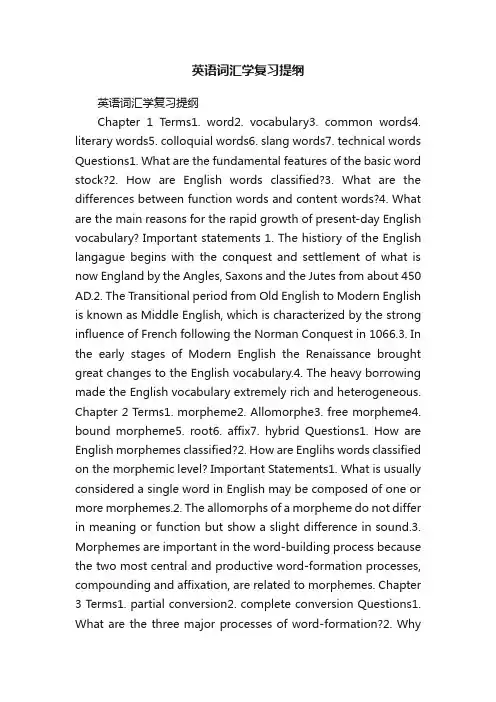
英语词汇学复习提纲英语词汇学复习提纲Chapter 1 Terms1. word2. vocabulary3. common words4. literary words5. colloquial words6. slang words7. technical words Questions1. What are the fundamental features of the basic word stock?2. How are English words classified?3. What are the differences between function words and content words?4. What are the main reasons for the rapid growth of present-day English vocabulary? Important statements 1. The histiory of the English langague begins with the conquest and settlement of what is now England by the Angles, Saxons and the Jutes from about 450 AD.2. The Transitional period from Old English to Modern English is known as Middle English, which is characterized by the strong influence of French following the Norman Conquest in 1066.3. In the early stages of Modern English the Renaissance brought great changes to the English vocabulary.4. The heavy borrowing made the English vocabulary extremely rich and heterogeneous. Chapter 2 Terms1. morpheme2. Allomorphe3. free morpheme4. bound morpheme5. root6. affix7. hybrid Questions1. How are English morphemes classified?2. How are Englihs words classified on the morphemic level? Important Statements1. What is usually considered a single word in English may be composed of one or more morphemes.2. The allomorphs of a morpheme do not differ in meaning or function but show a slight difference in sound.3. Morphemes are important in the word-building process because the two most central and productive word-formation processes, compounding and affixation, are related to morphemes. Chapter 3 Terms1. partial conversion2. complete conversion Questions1. What are the three major processes of word-formation?2. Whyare the criteria of a compound relative? Important Statements1. There are varioius ways of forming words, but by and large, the various processes can be classified on the basis of frequency of usage, into major or minor processes.2. Any rule of word formation is of limited productivity in the sense that not all words which result from the applicationn of the rule are acceptable; they are freely acceptable only when they have gained an institutional currency in the language.3. Prefixes modify the lexical meaning of the base. They do not genearlly alter the word-class of the base.4. Suffixes usually change the word-class of the base. Chapter 4 Terms1. blending2. back-formation3. clipp ing4. neoclassical formation Questions1. What are the differences between initialisms and acronyms? Important Statements1. On the whole, clipped words are used in less formal situations than their full-length equivalents.2. Most of the blends are related to daily life.3. The majority of backformed words are verbs.4. Reduplicatives are characterized by being rhymed or alliterated.5. The majority of neoclassical formations are scientific and technical.6. Genuine coinage is rare.7. Some new words are coined by analogy. Chapter 5 Terms1. motivation2. denotative meaning3. connotative meaning4. stylistic meaning5. affective meaning Questions1. What is the relationship between word form and its senses?2. What are the main types of word meaning? Important Statements1. The test of a genuinely onomatopeic word is its intelligibility to a foreigner who has no knowledge of the language in question.2. Denotative meaning is the central factor in linguistic communication.3. Lexical meaning is dominant in content words, whereas grammatical meaning is dominant in funciton words. Chapter 6 Terms1. radiation2. concatination3. prima ry meanin4. central meaning5. perfect homonyms6.homophones7. homographs Important Statements1. One-meaning words are very rare. They are very often scientific terms.2. It may be said that polysemy is the rule and monosemy is the exception.3. In some cases, the primary meaning and the central meaning coincide.4. Polysemic words and homonymous words are not only good candidates for humor, they can also produce other effects such as irony or heightened dramatic power. Chapter 7Terms1. complete synonyms2. relative synonyms3. hyponymy4. marked member5. unmarked member Questions1. In what respects do synonymous words differ? Important Statements1. An agreement in denotation is the most important criterion of synonymy.2. Two words aretotally synonymous only if they are fully identical in meaning and interchangeable in any context without the slightest alteration in connotative, affective and stylistic meanings.3. It is important to note that two forces militate against complete synonymy: vagueness of word meaning,and connotative, stylistic and affective meanings that cluster around words.4. In most cases the native word is more spontaneous, more informal and unpretentious, whereas the foreign word is learned, abstract or even abstruse.5. In the double scale pattern of synonyms the native term usually sounds warmer and more homely than its foreign counterpart.6. In the triple scale pattern of synonyms the difference in tone between the English and the French words is often slight; the Latin word is generally more bookish.7. Synnonyms are useful for avoiding repetition and for achieving precision in meaning and variety in style.8. Lexical antonymy is often stronger than syntactic negation.9. This semantic category obviously overlaps with hyponymy: both are involved with forming relaionships between words in the same general area ofmeaning. For parctical purposes, in the case of hyponymy, one should pay attention to the question of which specific term to use, while in the case of semantic field, one’s attention should be turned toward the highly probable collocations the words of each semantic field have in common. Chapter 8 Terms1. linguistic context2. ambiguity Questions1. What are the different types of context?2. What are the functions of context in determination of word meaning? 3. What are the different types of ambiguity? Important Statements1. When we say that the context determines the sense we mean not that it imposes a sense but that it selects one that is already there.2. Words rarely can be equated on a one-to-one basis between two languages. Chapter 9 Terms1. historical cause of changes in word meaning2. social cause of changes in word meaning3. linguistic cause of changes in word meaning4. psychological cause of changes in word meaning5. metaphor6. metonymy Questions1. What are the mian causes of changes in word meaning?2. What are the tendencies in semantic change? Important Statements1. Usually a literal meaning of a word remains along with a new metaphorical one.2. Broading speaking, change of meaning refers tothe alteration of the meaning of existing words, as well as the additionnn of new meaning to established words. Chapter 10Terms Idiom Question What points should we attention to if we want to use idioms appropriately? Chapter 11 Questions1. What are three stages in the growth of American English?2. What are the characteristics of American English? Chapter 12Terms1. prescriptive dictionaries 2. descriptive。
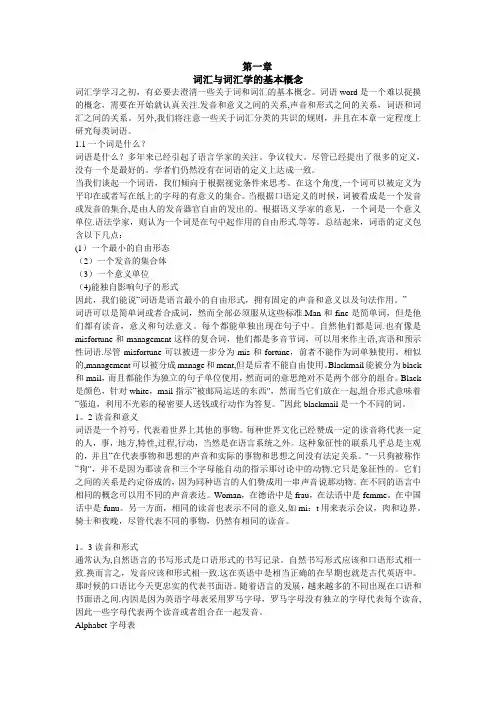
第一章词汇与词汇学的基本概念词汇学学习之初,有必要去澄清一些关于词和词汇的基本概念。
词语word是一个难以捉摸的概念,需要在开始就认真关注.发音和意义之间的关系,声音和形式之间的关系,词语和词汇之间的关系。
另外,我们将注意一些关于词汇分类的共识的规则,并且在本章一定程度上研究每类词语。
1.1一个词是什么?词语是什么?多年来已经引起了语言学家的关注。
争议较大。
尽管已经提出了很多的定义,没有一个是最好的。
学者们仍然没有在词语的定义上达成一致。
当我们谈起一个词语,我们倾向于根据视觉条件来思考。
在这个角度,一个词可以被定义为平印在或者写在纸上的字母的有意义的集合。
当根据口语定义的时候,词被看成是一个发音或发音的集合,是由人的发音器官自由的发出的。
根据语义学家的意见,一个词是一个意义单位.语法学家,则认为一个词是在句中起作用的自由形式.等等。
总结起来,词语的定义包含以下几点:(1)一个最小的自由形态(2)一个发音的集合体(3)一个意义单位(4)能独自影响句子的形式因此,我们能说“词语是语言最小的自由形式,拥有固定的声音和意义以及句法作用。
”词语可以是简单词或者合成词,然而全部必须服从这些标准.Man和fine是简单词,但是他们都有读音,意义和句法意义。
每个都能单独出现在句子中。
自然他们都是词.也有像是misfortune和management这样的复合词,他们都是多音节词,可以用来作主语,宾语和预示性词语.尽管misfortune可以被进一步分为mis和fortune,前者不能作为词单独使用。
相似的,management可以被分成manage和ment,但是后者不能自由使用。
Blackmail能被分为black 和mail,而且都能作为独立的句子单位使用,然而词的意思绝对不是两个部分的组合。
Black 是颜色,针对white,mail指示“被邮局运送的东西",然而当它们放在一起,组合形式意味着“强迫,利用不光彩的秘密要人送钱或行动作为答复。
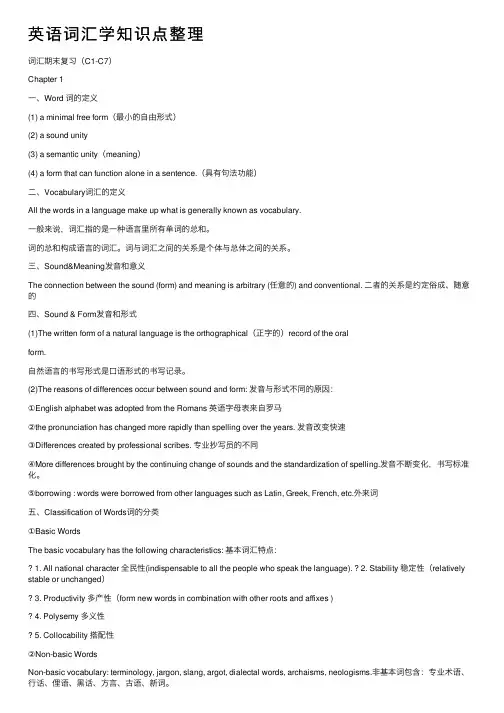
英语词汇学知识点整理词汇期末复习(C1-C7)Chapter 1⼀、Word 词的定义(1) a minimal free form(最⼩的⾃由形式)(2) a sound unity(3) a semantic unity(meaning)(4) a form that can function alone in a sentence.(具有句法功能)⼆、Vocabulary词汇的定义All the words in a language make up what is generally known as vocabulary.⼀般来说,词汇指的是⼀种语⾔⾥所有单词的总和。
词的总和构成语⾔的词汇。
词与词汇之间的关系是个体与总体之间的关系。
三、Sound&Meaning发⾳和意义The connection between the sound (form) and meaning is arbitrary (任意的) and conventional. ⼆者的关系是约定俗成、随意的四、Sound & Form发⾳和形式(1)The written form of a natural language is the orthographical(正字的)record of the oralform.⾃然语⾔的书写形式是⼝语形式的书写记录。
(2)The reasons of differences occur between sound and form: 发⾳与形式不同的原因:①English alphabet was adopted from the Romans 英语字母表来⾃罗马②the pronunciation has changed more rapidly than spelling over the years. 发⾳改变快速③Differences created by professional scribes. 专业抄写员的不同④More differences brought by the continuing change of sounds and the standardization of spelling.发⾳不断变化,书写标准化。
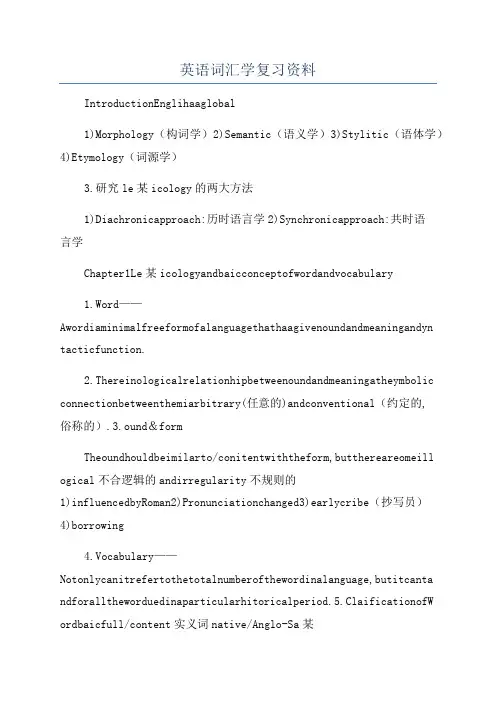
英语词汇学复习资料IntroductionEnglihaaglobal1)Morphology(构词学)2)Semantic(语义学)3)Stylitic(语体学)4)Etymology(词源学)3.研究le某icology的两大方法1)Diachronicapproach:历时语言学2)Synchronicapproach:共时语言学Chapter1Le某icologyandbaicconceptofwordandvocabulary1.Word——Awordiaminimalfreeformofalanguagethathaagivenoundandmeaningandyn tacticfunction.2.Thereinologicalrelationhipbetweenoundandmeaningatheymbolic connectionbetweenthemiarbitrary(任意的)andconventional(约定的,俗称的).3.ound&formTheoundhouldbeimilarto/conitentwiththeform,butthereareomeill ogical不合逻辑的andirregularity不规则的1)influencedbyRoman2)Pronunciationchanged3)earlycribe(抄写员)4)borrowing4.Vocabulary——Notonlycanitrefertothetotalnumberofthewordinalanguage,butitcanta ndforalltheworduedinaparticularhitoricalperiod.5.ClaificationofW ordbaicfull/content实义词native/Anglo-Sa某onwordfrequencynotionoriginnonbaic/vocabularyfunctional/empty功能词borrowed/loanCollocability(可搭配性)neutralintyle(中立性)(2)Twofeatureofnativewordfrequentinue1)wordtakenoverfromforeignlanguageareknowaborrowedwordorloan wordorborrowinginimpleterm.2)ItietimatedthatEnglihborrowingconti tute80percentofthemodernEnglihvocabulary3)TheEnglihlanguagehavat debt.Inanydictionaryome80%oftheentrieareborrowed.Chapter2ThedevelopmentoftheEnglihvocabulary1.OldEnglih属于Indo-Europeanlanguagefamily(印欧语系)——Germanic(日耳曼语系),与德语最相似.2.Hitory1)OldEnglih(450-1150)a.Thefirtpeopleknowntoinhabit(居住)EnglandwereCelt,thelanguagewaCeltic(凯尔特语).b.TheecondlanguagewatheLatin(拉丁语)oftheRomanLegion(罗马军队).Romaninvaion→Anglo-Sa某on 三个事件TheintroductionofChri tianity→拉丁文的涌入Vikinginvaion(北欧海盗)andScandinavian斯堪的纳维亚语传入word文档可自由复制编辑2)MiddleEnglih(1150-1500)在英语发展过程在哪个阶段出现三语鼎立的现象?French,Latin,EnglihinMiddleEnglihperiodeael,port,freight,出现于英语发展的哪个阶段,属于哪一种外来词的引入?MiddleEnglih,Dutch(带来了2500个词汇)3)ModernEnglih (1500-uptonow)TheRenaiance(文艺复兴):LatinandGreekwererecognizedathelanguageoftheWeternworld’gr eatliteraryheritage(文化遗产).TheIndutrialRevolution(工业革命):17世纪中期Withthegrowthofcolonization(殖民化),Britihtentacle(魔爪)beganatretchingoutoftoeverycorneroftheglobe,thuenablingEnglihtoaborb(吸收)wordfromallmajorlanguageoftheworld.十六世纪,有一种新工业Printing出现对词汇的发展产生重要的影响,这导致oundandform出现concord(一致)和tandardization第二次世界大战以后,大量外来词进入英语中,如:Maojacket,blackbelt,kongfu标准化Inflectionallanguage屈折语Analyticallanguage分析语TherapiddevelopmentofmoderncienceandtechnologySocial,economi candpoliticalchangeTheinfluenceofothercultureandlanguageThreemodeofvocabularyde velopmentChapter3ThetructureofEnglihwordword.)Free→cantandaloneaaword/independentofothermorphemeTypeprefi某ation前缀Le某ical→derivational→affi某ationBound→addedtoothermorphemeuffi某ation后缀Grammatical→inflectional2.Morph——Amorphememutberealizedbydicrete(离散的)unit.Theeactualpokenminimalcarrierofmeaningaremorph.Monomorpheni cword——morphemearerealizedbyinglemorph.Allomorph(词素变体)——Somemorphemearerealizedbymorethanonemorphaccordingtotheirpoition .3.Root——Arootithebaicformofaword,whichcannotbefurtheranalyzedwithouttota lloofidentity.(Whatremainofawordaftertheremovalofallaffi某e.)Stem——aformtowhichaffi某eofanykindcanbeadded.Bae——refertoaformtowhichaffi某eofanykindcanbeadded.Itcanbearootortem.atemmayconitofainglerooto rtworootandarootpluaaffi某.atemcanbearootoraformbiggerthanaroot.请加以区别下面两个词的特征:nation,dict加以理论的分析(1)Bothnationanddictbelongtoroot,nationifreeroot,whichcanfun ctionaloneinaentence,Chapter4Word-formationinEnglih1.Therearefourmaintypeofword-formationinEnglih.word文档可自由复制编辑(1)★Affi某ation(prefi某ationanduffi某ation)构词能力最强Affi某ationigenerallydefinedatheformationofwordbyaddingwordformingorde rivationalaffi某etotem.fullconverion——Itcantakeanindefinitarticle(不定冠词)or-(e)toindicateingularorpluralnumber.e.g.black→ablackdrinkable→d rinkablepartialconverion——mutbeuedtogetherwithdefinitearticle.e.g.rich→therich2.Othertype ofword-formation(1)Clipping/hortening——hortenalongerwordbycuttingapartoftheoriginanduingwhatremainintea d.quake(earthquake)dorm(dormitory)pop(popularmuic)flu (influenza)(2)Acronymy首字母缩略法——joiningtheinitialletterofnameofocialandpoliticalorganizationorpe cialphraeandtechnicaltermeg:VOA-VoiceofAmericaTV-televiion绝大多数blending都是nouneg:mog(烟雾)frommoke+fogtele某(电传机)fromteleprinter+e某changeMedicare(医疗保险)frommedical+carelunarnaut(登月宇航员)fromlunar+atronaut(4)Back-formation逆构词法——iaproceofword-formationbywhichawordicreatedbythedeletion删除ofauppoedaffi某.donate(donation)loaf(loafer)babyit(babyitter)laze(lazy)Chapter5Wordmeaning1.Analytical(referential)分析的Reference–therelationhipbetweenlanguageandtheworld.Operational(conte某tual)运用到具体场景中Concept–whichbeyondlanguageithereultofhumancognitionreflectingthe objectiveworldinthehumanmind★Sene1)enedenotetherelationhipinidethelanguage.Theeneofane某preioniitplaceinaytemofemanticrelationhipwithothere某preioninthelanguage.’2)Sincetheeneofane某preioninotathing,itioftendifficulttoaywhatortofidentityiti.Itial oanabtraction.3)Everywordthathameaninghaene(noteverywordhareference)2.Motivation(理据)——accountfortheconnectionbetweenthelinguitic(语言学的)ymbolanditmeaning.non-motivatedOnomatopoeic(拟声的)——thewordwhoeounduggettheirmeaning.Semantic(语义学的)——refertothementalaociationuggetedbytheconceptual概念上的meaningofaword.eg:atthefootofmountain,themouthofriverword文档可自由复制编辑Etymological(词源学的)——Thehitoryoftheworde某plainthemeaningoftheword.3.TypeofmeaningGrammatical语法–refertothatpartofthemeaningofthewordwhichindicategrammaticalconc eptorrelationhipConceptual概念——themeaninggiveninthedictionaryandformthecore核心ofword-meaning.Le某ical词汇Connotative内涵意义eg:Mother—afemaleparent—loveAociative联想Stylitic语体1)formal2)neutral3)informalAffective/Emotive——appreciativeandpejorativeCollocative固定搭配Chapter6SenerelationSynchronicapproachRadiation辐射像车轮式一样进行发展的语义e.g.face,neck(3)TwoproceofdevelopmentConcatenation–meaning―linkingtogether‖串联 2.Homonymy(1)定义:Homonymaregenerallydefinedaworddifferentinmeaningbuteitheridenti cal(完全相同的)bothinoundandpellingoridenticalonlyinoundorpelling.PerfectHomonym同音同形异义词e.g.bear忍受;熊ball球;舞会(2)TypeHomograph同形异义e.g.minute分钟;微小的(1)定义:Synonymareworddifferentinoundandpellingbutmotnearlyalikeore某actlytheameinmeaning.Aboluteregioned地域(BritihEnglih&AmericanEnglih)(2)TypetyliticdegreeRelative(Near)hadeofmeaningemotiverangecollocative搭配Borrowing(themotimportantource)(1)定义:Antonymyiconcernedwithemantic语义学的oppoition.Relative(dependoneachother)eg:parent—child,ell—buy,predeceor前辈—ucceor继承者word文档可自由复制编辑(3)Characteritic1)Antonymareclaifiedonthebaiofemanticoppoition.2)Awordwhichhamorethanonemeaningcanhavemorethanoneantonym.3)Antonymdifferinemanticincluion.4)Contrarytermaregradableantonym,differingindegreeofintenity,oeach haitowncorrepondingoppoition.(4)Ue。
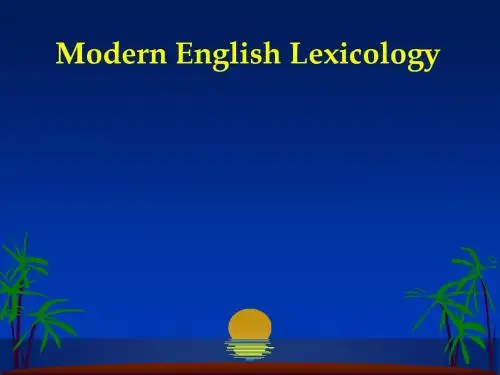
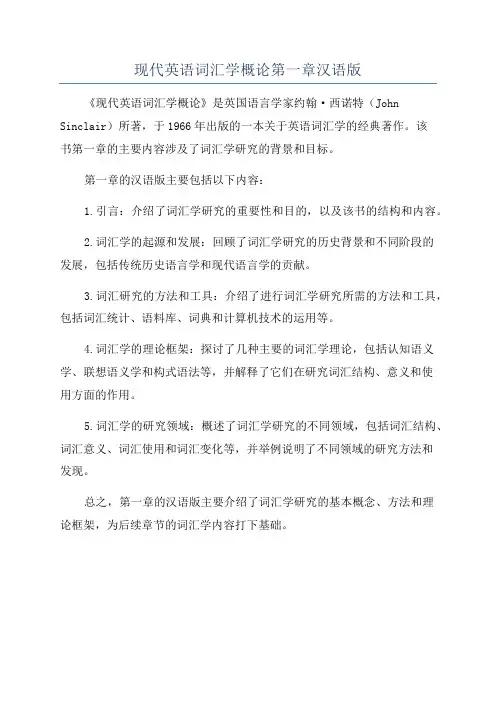
现代英语词汇学概论第一章汉语版
《现代英语词汇学概论》是英国语言学家约翰·西诺特(John Sinclair)所著,于1966年出版的一本关于英语词汇学的经典著作。
该
书第一章的主要内容涉及了词汇学研究的背景和目标。
第一章的汉语版主要包括以下内容:
1.引言:介绍了词汇学研究的重要性和目的,以及该书的结构和内容。
2.词汇学的起源和发展:回顾了词汇学研究的历史背景和不同阶段的
发展,包括传统历史语言学和现代语言学的贡献。
3.词汇研究的方法和工具:介绍了进行词汇学研究所需的方法和工具,包括词汇统计、语料库、词典和计算机技术的运用等。
4.词汇学的理论框架:探讨了几种主要的词汇学理论,包括认知语义学、联想语义学和构式语法等,并解释了它们在研究词汇结构、意义和使
用方面的作用。
5.词汇学的研究领域:概述了词汇学研究的不同领域,包括词汇结构、词汇意义、词汇使用和词汇变化等,并举例说明了不同领域的研究方法和
发现。
总之,第一章的汉语版主要介绍了词汇学研究的基本概念、方法和理
论框架,为后续章节的词汇学内容打下基础。
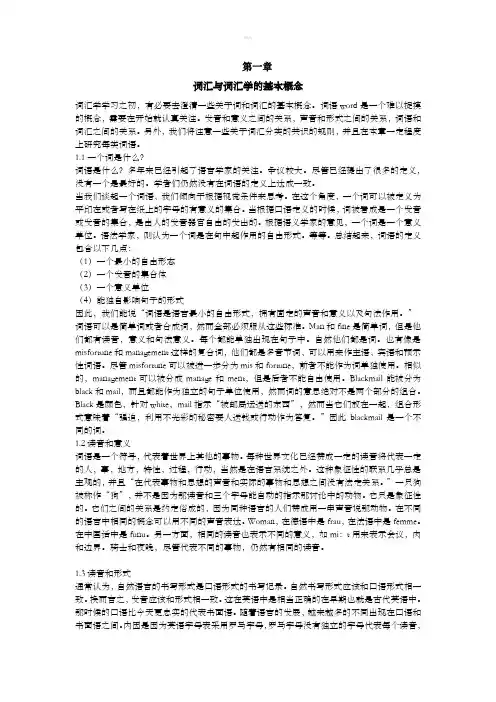
第一章词汇与词汇学的基本概念词汇学学习之初,有必要去澄清一些关于词和词汇的基本概念。
词语word是一个难以捉摸的概念,需要在开始就认真关注。
发音和意义之间的关系,声音和形式之间的关系,词语和词汇之间的关系。
另外,我们将注意一些关于词汇分类的共识的规则,并且在本章一定程度上研究每类词语。
1.1一个词是什么?词语是什么?多年来已经引起了语言学家的关注。
争议较大。
尽管已经提出了很多的定义,没有一个是最好的。
学者们仍然没有在词语的定义上达成一致。
当我们谈起一个词语,我们倾向于根据视觉条件来思考。
在这个角度,一个词可以被定义为平印在或者写在纸上的字母的有意义的集合。
当根据口语定义的时候,词被看成是一个发音或发音的集合,是由人的发音器官自由的发出的。
根据语义学家的意见,一个词是一个意义单位。
语法学家,则认为一个词是在句中起作用的自由形式。
等等。
总结起来,词语的定义包含以下几点:(1)一个最小的自由形态(2)一个发音的集合体(3)一个意义单位(4)能独自影响句子的形式因此,我们能说“词语是语言最小的自由形式,拥有固定的声音和意义以及句法作用。
”词语可以是简单词或者合成词,然而全部必须服从这些标准。
Man和fine是简单词,但是他们都有读音,意义和句法意义。
每个都能单独出现在句子中。
自然他们都是词。
也有像是misfortune和management这样的复合词,他们都是多音节词,可以用来作主语,宾语和预示性词语。
尽管misfortune可以被进一步分为mis和fortune,前者不能作为词单独使用。
相似的,management可以被分成manage和ment,但是后者不能自由使用。
Blackmail能被分为black和mail,而且都能作为独立的句子单位使用,然而词的意思绝对不是两个部分的组合。
Black是颜色,针对white,mail指示“被邮局运送的东西”,然而当它们放在一起,组合形式意味着“强迫,利用不光彩的秘密要人送钱或行动作为答复。
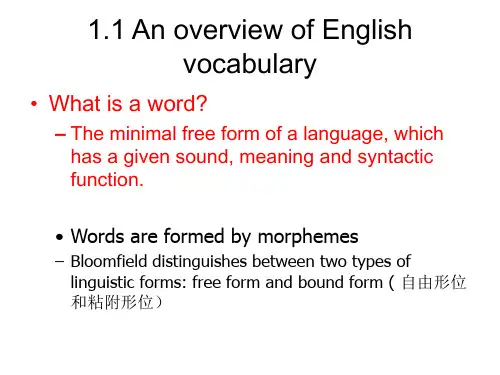
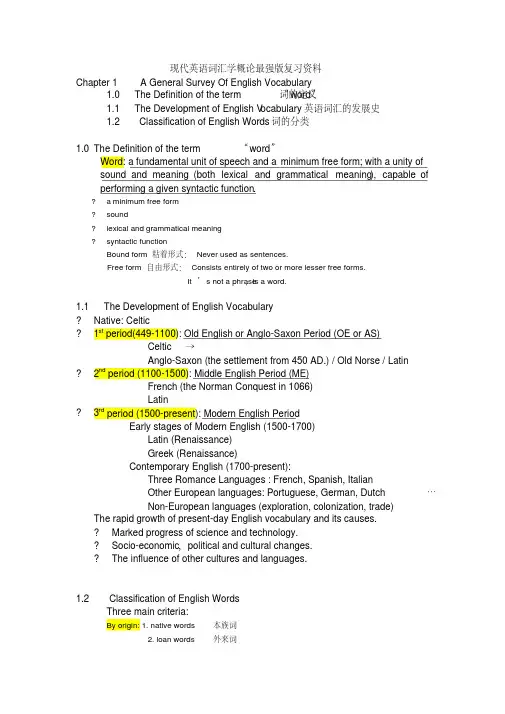
现代英语词汇学概论最强版复习资料Chapter 1 A General Survey Of English Vocabulary词的定义1.0 The Definition of the term “word” 1.1 The Development of English V ocabulary英语词汇的发展史1.2 Classification of English Words词的分类1.0The Definition of the term “word”Word: a fundamental unit of speech and a minimum free form; with a unity of sound and meaning (both lexical and grammatical meaning), capable of performing a given syntactic function.? a minimum free form?sound?lexical and grammatical meaning?syntactic functionBound form粘着形式:Never used as sentences.Free form 自由形式:Consists entirely of two or more lesser free forms.,is a word.It’s not a phrase1.1 The Development of English Vocabulary?Native: Celtic?1st period(449-1100): Old English or Anglo-Saxon Period (OE or AS)Celtic → Anglo-Saxon (the settlement from 450 AD.) / Old Norse / Latin?2nd period (1100-1500): Middle English Period (ME)French (the Norman Conquest in 1066)Latin?3rd period (1500-present): Modern English PeriodEarly stages of Modern English (1500-1700)Latin (Renaissance)Greek (Renaissance)Contemporary English (1700-present):Three Romance Languages : French, Spanish, ItalianOther European languages: Portuguese, German, Dutch …Non-European languages (exploration, colonization, trade) The rapid growth of present-day English vocabulary and its causes.?Marked progress of science and technology.?Socio-economic,political and cultural changes.?The influence of other cultures and languages.1.2 Classification of English WordsThree main criteria:By origin: 1. native words 本族词2. loan words 外来词By level of usage: 1. common words 普通词2. literary words 书面词3. colloquial words 口头词4. slang words 俚语5. technical words 术语By notion: 1. function words 功能词2. content words 实义词By origin:1. native words 本族词2. loan words 外来词Native words: words of Anglo-Saxon origin or of old EnglishFeatures of native words:?Most are monosyllabic?forming the great majority of the basic word stockLoan / borrowed words: those borrowed from other languagesBasic word stock:?auxiliary, modal verbs, numerals, pronouns, prepositions, conjunctions, the most frequently used words (essential to life)?National character?Stability?Word-forming ability?Ability to form collocationsBy level of usage:1. Common words 普通词2. Literary words 书面词3. Colloquial words 口头词4. Slang words 俚语5. Technical words 术语*There are no clear-cut boundaries between the various classes of words.Common words普通词:?connected with the ordinary things or activities necessary to everyday life?The core of the common words is the basic word stock.?Stylistically neutralLiterary words书面词:?chiefly used in writing, especially in books written in a more elevated style, in official documents, or in formal speeches.?Most are of French, Latin or Greek origin.?Among the literary word, two categories are noteworthy:?archaic words (c.f. obsolete words)?poetical wordsSlang俚语:?Language, words or phrases of a vigorous, colorful, facetious, or taboo nature, invented for specific occasions, or uses or derived from the unconventionaluse of the standard vocabulary?Not generally used in informal conversation unless the speakers are on intimate terms?Embracing those daring and new expression that have not been accepted as standard EnglishThe chief reason for use of slang: secure freshness and noveltyTechnical words术语:?used in various fields: science, profession or trade, art, sport?increasing precision in nomenclature?one specific meaning?Latin or Greek in originBy notion:1. function words 功能词2. content words 实义词Function words:?determiners, conjunctions, prepositions, auxiliaries?not having much lexical meaning?serving grammatically:Behaving like grammatical signals or functional markers,Expressing the kinds of connection between content wordsConstructing acceptable English sentences?small in number and stable:In relatively closed listsBelonging to a relatively small and permanent set of words)?high frequency。
Word :a minimum free form of a language. With a unity of s ound and meaning(both lexical meaning and grammatical meaning),performing syntactic meaningCriteria of words: by origin(native—old English )( and loan language—borrowed English),by level of usage(common words, literary ,colloquial, slang and technical words);by notions(function and content words)Morpheme: smallest meaningful linguistic unit of language, not divisible or analyzable into smaller form. A morpheme is also two-facet language unit which possesses sound and meaning.Classification of morphemes: free morpheme-utter alone with meaning(a free morpheme is a word in traditional sense); bound morpheme—must appear with one other morpheme, free or bound)Root: the basic unchangeable part of the word, convey the main lexical meaning of the word. Either free or bound.(free roots and bound roots)Affixes: ----inflectional affixes(have only particular grammatical meaning)and derivational affixes.(added morpheme to create new words.)---prefixes and suffixesWord-formationThree major processes : compounding(joining tow or more bases to form a new unit of compound words)Derivation(forming a new word by addition of a word element)Conversion(a word of certain word-class is shifted into another word-class without any affixes)Eight minor processes :Acronymy (Initialisms –using the first letter from proper name ,phrase, technical words)Ainitialism is pronounced letter by letter) and acronyms—from the initial letters of the name of an organization or scientific term)==are pronounced as words.Clipping(deletion of one or more syllables from a word—usually a noun, which is also available in its full form)Classification—back clipping, front clipping ,front and back clipping and phrase clipping.)Blending---formed by combining the meanings and sound of tow words.one of which is not full form or both of which are not full form. )不完整拼缀Back-formation(coined by the deletion of a supposed affix from a longer form already present in the language.)Words from proper names(including names of scientists, names of politicians and statesman, names of places, trademark, literature)Reduplication(a compound word is created by the repetition(1)of one word like go-go(2)almost identical words with a change in the vowel’s such as ping-pong.(3)of two almost identical words with a change in the initial consonants ,as in teenyweeny.Neoclassical(new words are formed from elements derived from Latin and Greek)The majority of neoclassical formations are scientific and technical.MiscellaneousWord meaning and sense relations1,conventionality—no way to explain why this or that sound-symbol and its sense.2,motivation—phonetic ,morphological, sematic3,main types of word meaning(interrelated andinterdependent)---class and inflectionalparadigm)andmeaning; connotative meaning—emotional association; social or stylistic meaning and affective meaning)Binary opposites.二相对立Polysemy—a term used in sematic analysis to refer to lexical item which has a range of meanings.)T wo approaches—diachronic and synchronic.---primary meaning and derived meaning, central meaning and secondary meaning(in some cases, the primary meaning and the central meaning coincide.)Two processes leading to polysemy---radiation(each of the secondary meanings may become a center of further radiation),concatenation(linking together, like the links of a chain.Homonymy(---pronounced alike, spell alike, or both.)---types of homonyms(perfect homonyms—word identical in sound and spelling but different in meaning)(Homophones---identical in sound but different in spelling and meaning.)(Homographs—identical in spelling but different in sound and meaning.)Polysemic and homonymous words are stylistically useful to achieve humour or irony, or to heighten dramatic effect. Synonymy(—identical in meaning but different in sound and spelling.)--- Complete synonyms(absolute),Relative synonyms.Antonymy (--opppsiteness of meaning)---contrary, complementary and conversives ….Antonyms classified on the basis of morphological structure: root antonyms and derivational antonyms.Marked and unmarked words---subsume.(Marked members can not be used to include unmarked member.) Hyponymy—(relationship which obtains specific and general lexical items)Superordinate term(an upper term),Subordinate terms(a lower term)===hierarchical system Sematic field---is not simply a listing of independent items, organized into areas or field.Charateristic of the same sematic field.1),word frequency in the same semantic varies 2)these words are semantically interdepent.3) words in the same semantic field are likely to have a number of collocation on common. Changes in word meaning---1,causes:historical,social,foreign influence, linguistic and psychological .2, Four tendencies in sematic change---restriction, extension, degeneration, elevation (of meaning)具体化,普遍化,语义转贬,语义改良。
《英语词汇学》复习资料(总24页)--本页仅作为文档封面,使用时请直接删除即可----内页可以根据需求调整合适字体及大小--《英语词汇学》复习资料Chapter 11. Word —— A word is a minimal free form of a language that has a given sound and meaning and syntactic function.2. There is no logical relationship between sound and meaning as the symbolic connection between them is arbitrary and conventional. . “woman” means ’Frau’ in German,’Femme’ in French and ’Funv ’in Chinese. On the other hand, the same sound/rait/ can mean right, rite and write, though denoting different things, yet have the same sound.3. The difference between sound and form result from 4 major factors.(At least 80%of the English words fit consistent spelling patterns)a). the internal reason is English alphabet does not have a separate letter to represent each sound in the language.b). Pronunciation has changed more rapidly than spellingc). Influence of the work of scribes/printing freezes the spelling of words in 1500d). Borrowing of foreign language4. Vocabulary —— Vocabulary is most commonly used to refer to the sum total of all the words of a language. It can also refer to all the words of a given dialect, a given book, a given subject and all the words possessed by an individual person as well as all the words current in a particular period of time in history.The general estimate of the present day English vocabulary is over 1 million words.of Words—by use frequency, by notion, by origin1). Basic word stock – the foundation of the vocabulary.1. all national character (most important)– natural phenomenamost common things and phenomena of the human body and relationsworld around us names of plants and animalsaction, size, domain, statenumerals, pronouns, prep. ,conj.2. stability – they donate the commonest thing necessary to life, they are like to remain unchanged. Only relative, some are undergoing some changes. But the change is slow.. arrow, bow, chariot, knight – past electricity, machine, car, plane —— now3. productivity – they are mostly root words or monosyllabic words, they can form new words with other roots and affixes. . foot – football, footage, footpath, footer4. polysemy – often possess more than one meaning. Become polysemous.. take to move or carry from one place to anotherto remove5. collocability – quite a number of set expressions, idiomatic usages, proverbial saying and others. heart – a change of heart, a heart of goldNon-basic vocabulary ——1. terminology – technical termsphotoscanning, hepatitis, indigestion, penicillin, algebra, trigonometry, calculus2. jargon – specialized vocabulary in certain professions.Bottom line, ballpark figures, bargaining chips, hold him back, hold him in, paranoid3. slang —— substandard words often used in informal occasionsdough and bread, grass and pot, beaver, smoky, bear, catch, holler, Roger, X-rays,Certain words are labeled slang because of their usage.4. argot – words used by sub-cultured groupscan-opener, dip, persuadercant, jargon , argot are associated with, or most available to, specific groups of the population.5. dialectal words – only by speakers of the dialectbeauty, chook, cocky, station, auld, build, coo, hame, lough, bog6. archaisms – words no longer in common use or restricted in use. In older poems, legal document and religious writing or speech.7. neologism – newly created words with new meaning . microelectronics, futurology, AIDS, internet, E-mailold meaning acquired new meaning . mouse, monitor2). Content word (notional word)– denote clear notions.Functional word (empty word, form word)– do not have notions of their own, express the relation between notions,words and sentences.a. Content words constitute the main body of the English vocabulary are numerous.Functional words are in a small number.b. Content words are growing.Functional words remain stable.c. Functional words do far more work of expression than content words.3). Native words – are words brought to Britain in the 15 century by the German tribes. Ango-Saxon Words,50000-60000 What is true of the basic word stock is also true of native world. More are1. neutral in style (not stylistical specific )2. frequent in use (in academic fields and science French, Latin or Greek are used)(usage 70-90%)Borrowed words (loan words, borrowing)– words taken over from foreign language. 80%According to the degree of assimilation and manner of borrowing, we can bring the loan words under 4 classes.– words borrowed early and now are well assimilated into English language.. port from portus(L) shift, change, shirt, pork cup from cuppa(L)– retained their original pronunciation and spelling. décor(F) blitzkreeg(G) emir, intermez, rowtow, bazaar, rajar, status quoloans – formed from the existing material in the English language but modeled on the patterns taken from another language.1). Word translated according to the meaning. mother tough from lingua maternal(L)black humor from humor noirlong time no see, surplus value, master piece2). Words translated according to the sound. kulak from kyrak(Russ)lama from lama(Tib)ketchup tea4. Semantic loans – their meaning are borrowed from another language. stupid old dump new sassy dream old joy and peacepioneer old explorer/person doing pioneering work new a member of the young pioneerfresh old impertinent, sassy, cheekyChapter 2Indo-European language family (Europe, the Near East, India)Balto –Slavic Indo-Iranian Italic GermanicPrussian Persian Portuguese NorwegianLithuanian Hindi Spanish IcelandiePolish Italian DanishBulgarian Roumanian SwedishSlovenian French EnglishRussian GermanAlbanian Armenian Celtic HellenicIrish GreekBretonScottish2. History (时间,历史事件,特征)1) Old English (450-1150) totally 50,000-60,000 wordsThe 1st people known to inhabit England were Celts, the language was Celtic.The second language was the Latin of the Roman Legions.The Germanic tribes called angles, Saxons and Jutes and their language, Anglo-Saxon dominated and blotted out the Celtic. Now people refer to Anglo-Saxon as old English.At the end of 6th century, the introduction of Christianity has a great impact on the English vocabulary.The common practice was to create new words by combining two native words.In the 9th century, many Scandinavian words came into English. At least 900 words of Scandinavian are in modern English, our daily life and speech.特点: highly inflected languagecomplex endings or vowel changes (full ending)2) Middle English (1150-1500) English, Latin, FrenchUntil 1066, although there were borrowings from Latin, the influence on English was mainly Germanic. But the Norman Conquest started a continual flow of French words into English.By the end of the 13th century, English gradually come back into public areas.Between 1250 and 150 about 9000 words of French origin come into English. 75% of them are till in use today.As many as 2500 words of Dutch origin come into English.特点: fewer inflectionsleveled ending3) Modern English (1500-up to now) early modern English (1500-1700)late modern English(1700-up to now)The Renaissance,Latin and Greek were recognized as the languages of the Western world’s great literary heritage.The Industrial Revolution was in the mid-17 century. With the growth of colonization, British tentacles began a stretching out of to every corner of the globe, thus enabling English to absorb words from all major languages of the world.After World War II, many new words have been created to express new ideas, inventions and scientific achievements.More words are created by means of word-formation.thousands and thousands of new words have been entered to express new ideas inventions, and scientific achievements.more words are created by means of word-formation.in modern English, word endings were mostly lost with just a few exceptions English has evolved from a synthetic language to the present analytic language.science and technology terms make up about 45% of new words. words associated with life-style constitute of 24% and social and economic terms amount to over 10% .mention should be made of an opposite process of development . old words falling out if use.特点: ending are almost lost.3. Three main sources new wordsrapid development of modern science and technology, economic and political changesinfluence of other cultures and languages4. Three modes of vocabulary development1. Creation – the formation of new words by using the existing materials, namely roots, affixes and other elements. (This is the most important way of vocabulary expansion.)2. Semantic change - an old form which take on a new meaning to meet the new need.3. Borrowing – to take in words from other languages.(particularly in earlier time)4. (Reviving archaic or obsolete)French 30%, Latin 8%, Japanese Italian 7%, Spanish 6%, German Greek 5%, Russian Yiddish 4%Chapter 31. Morpheme —— A morpheme is the smallest meaningful unit of a language. (The smallest functional unit in the composition of words.)—— A morpheme must be realized by discrete units. These actual spoken minimal carriers of meaning are morphs.words – morphemes are realized by single morphs.——Some morphemes are realized by more than one morph according to their position. Such alternative morphs are allomorphemes. . the morpheme of plurality (-s) has a number if allomorphemes in different sound context, . in cats/s/, inbags/z/, in matches/iz/.5. Free morphemes or Free root —— The morphemes have complete meaning and van be used as free grammatical units in sentences, . cat, walk. They are identical with root words. morphemes which are independent of other morphemes are considered to be free.6. Bound Morphemes —— The morphemes cannot occur as separate words. They are bound to other morphemes to form words, . recollection (re+collect+ion) collect – free morpheme re-and –ion are bound morphemes. (include bound root and affix) Bound morphemes are found in derived words.7. Bound root —— A bound root is that part of the word that carries the fundamental meaning just like a free root. Unlike a free root, it is a bound form and has to combine with other morphemes to make words. Take -dict- for example: it conveys the meaning of “say or speak” as a Latin root, but not as a word. With the prefix pre-(=before)we obtain the verb predict meaning “tell beforehand”。
Chapter one The basic concepts of words and vocabulary1.1 The definition of a word(1)一个最小的自由形态(2)一个发音的集合体(3)一个意义单位(4)能独自影响句子的形式因此,我们能说“词语是语言最小的自由形式,拥有固定的声音和意义以及句法作用。
”1.2 vocabularyAll the words in a language make up its vocabulary. The general estimate of the English vocabulary is over one million words.1.3Sound and meaning词语是一个符号,代表着世界上其他的事物。
每种世界文化已经赞成一定的读音将代表一定的人,事,地方,特性,过程,行动,当然是在语言系统之外。
这种象征性的联系几乎总是主观的,并且“在代表事物和思想的声音和实际的事物和思想之间没有法定关系。
”1.4 sound and form在古英语中,口语比今天更忠实地代表书面语,但随着语言的发展,越来越多的不同出现在口语和书面语之间。
有以下几点原因:1.内因是因为英语字母表采用罗马字母,罗马字母没有独立的字母代表每个读音,因此一些字母代表两个读音或者组合在一起发音。
2.另一个原因是发音比拼写的变化快,在一些时候还拉开了距离。
在最近五百年里,尽管口语发音已经出现了显著的变化,却没有相应的拼写变化。
Another reason for this is that the pronunciation has changed more rapidly than spelling over the years, and in some cases the two have drawn far apart.3.第三个原因是一些早期的书写员发明了一些不同Those scribes had made some change to the word spelling4.到1500年年末,印刷已经变得非常普及。
以下是我整理的英语词汇学的资料。
我在考的时候主要就是靠这个东东。
希望对还没有过的⼈有所帮助。
⼤家请注意:笔记中⼤多数是以名词解释的形式出现的,这些是绝对的基础,应该⼀字不漏的背下来。
其实不少简答题也就是⼏个定义的汇总,再加上个例⼦就可以拿满分了。
区分两个词的区别,主要还是指明其各⾃的定义。
第⼀章 1. Word —— A word is a minimal free form of a language that has a given sound and meaning and syntactic function. 2. There is no logical relationship between sound and meaning as the symbolic connection between them is arbitrary and conventional. E.g. “woman” means ’Frau’ in German, ’Femme’ in French and ’Funv ’in Chinese. On the other hand,the same sound /rait/ can mean right, rite and write, though denoting different things, yet have the same sound. 3. The difference between sound and form result from 4 major factors. (At least 80%of the English words fit consistent spelling patterns) a). the internal reason is English alphabet does not have a separate letter to represent each sound in the language. b). Pronunciation has changed more rapidly than spelling c). Influence of the work of scribes/printing freezes the spelling of words in 1500 d). Borrowing of foreign language 4. Vocabulary —— Vocabulary is most commonly used to refer to the sum total of all the words of a language. It can also refer to all the words of a given dialect, a given book, a given subject and all the words possessed by an individual person as well as all the words current in a particular period of time in history. The general estimate of the present day English vocabulary is over 1 million words. 5.Classification of Words—by use frequency, by notion, by origin 1). Basic word stock – the foundation of the vocabulary. 1. all national character (most important)– natural phenomena most common things and phenomena of the human body and relations world around us names of plants and animals action, size, domain, state numerals, pronouns, prep. ,conj. 2. stability – they donate the commonest thing necessary to life, they are like to remain unchanged. Only relative,some are undergoing some changes. But the change is slow. e.g. arrow, bow, chariot, knight – past electricity, machine, car, plane —— now 3. productivity – they are mostly root words or monosyllabic words, they can form new words with other roots and affixes. e.g. foot – football, footage, footpath, footer 4. polysemy – often possess more than one meaning. Become polysemous. e.g. take to move or carry from one place to another to remove 5. collocability – quite a number of set expressions, idiomatic usages, proverbial saying and others e.g. heart – a change of heart, a heart of gold Non-basic vocabulary —— 1. terminology – technical terms photoscanning, hepatitis, indigestion, penicillin, algebra, trigonometry, calculus 2. jargon – specialized vocabulary in certain professions. Bottom line, ballpark figures, bargaining chips, hold him back, hold him in, paranoid 3. slang —— substandard words often used in informal occasions dough and bread, grass and pot, beaver, smoky, bear, catch, holler, Roger, X-rays, Certain words are labeled slang because of their usage. 4. argot – words used by sub-cultured groups can-opener, dip, persuader cant, jargon , argot are associated with, or most available to, specific groups of the population. 5. dialectal words – only by speakers of the dialect beauty, chook, cocky, station, auld, build, coo, hame, lough, bog 6. archaisms – words no longer in common use or restricted in use. In older poems, legal document and religious writing or speech. 7. neologism – newly created words with new meaning e.g. microelectronics, futurology, AIDS, internet, E-mail old meaning acquired new meaning e.g. mouse, monitor 2). Content word (notional word) – denote clear notions. Functional word (empty word, form word) – do not have notions of their own, express the relation between notions, words and sentences. a. Content words constitute the main body of the English vocabulary are numerous. Functional words are in a small number. b. Content words are growing. Functional words remain stable. c. Functional words do far more work of expression than content words. 3). Native words – are words brought to Britain in the 15 century by the German tribes. Ango-Saxon Words, 50,000-60,000 What is true of the basic word stock is also true of native world. More are 1. neutral in style (not stylistical specific ) 2. 2.frequent in use (in academic fields and science French, Latin or Greek are used)(usage 70-90%) Borrowed words (loan words, borrowing) – words taken over from foreign language. 80% According to the degree of assimilation and manner of borrowing, we can bring the loan words under 4 classes. 1.Denizens – words borrowed early and now are well assimilated into English language. e.g. port from portus(L) shift, change, shirt, pork cup from cuppa(L) 2.Aliens – retained their original pronunciation and spelling e.g. décor(F) blitzkreeg(G) emir, intermez, rowtow, bazaar, rajar, status quo 3.translation loans – formed from the existing material in the English language but modeled on the patterns taken fromanother language. 1). Word translated according to the meaning e.g. mother tough from lingua maternal(L) black humor from humor noir long time no see, surplus value, master piece 2). Words translated according to the sound e.g. kulak from kyrak(Russ) lama from lama(Tib) ketchup tea 4. Semantic loans – their meaning are borrowed from another language e.g. stupid old dump new sassy dream old joy and peace pioneer old explorer/person doing pioneering work new a member of the young pioneer fresh old impertinent, sassy, cheeky。
大家请注意:笔记中大多数是以名词解释的形式出现的,这些是绝对的基础,应该一字不漏的背下来。
其实不少简答题也就是几个定义的汇总,再加上个例子就可以拿满分了。
区分两个词的区别,主要还是指明其各自的定义。
第一章Basic Concepts of Words and Vocabulary1. 词的定义Word —— A word is a minimal free form of a language that has a given sound and meaning and syntactic function.2.声音与意义的关系There is no logical relationship between sound and meaning as the symbolic connection between them is arbitrary and conventional.. “woman” means ’Frau’ in German,’Femme’ in French and ’Funv ’in Chinese. On the other hand,the same sound /rait/ can mean right,rite and write,though denoting different things,yet have the same sound.3.读音与拼写不一致的原因The difference between sound and form result from 4 major factors.(At least 80%of the English words fit consistent spelling patterns)a). the internal reason is English alphabet does not have a separate letter to represent each sound in the language.b). Pronunciation has changed more rapidly than spelling¥c). Influence of the work of scribes/printing freezes the spelling of words in 1500d). Borrowing of foreign language4. 词汇的含义Vocabulary ——Vocabulary is most commonly used to refer to the sum total of all the words of a language. It can also refer to all the words of a given dialect,a given book,a given displine and all the words possessed by an individual person as well as all the words current in a particular period of time in history.The general estimate of the present day English vocabulary is over 1 million words.5.词汇的分类的原则Classification of Words—by use frequency,by notion,by originthe English vocabulary consist of words of all kinds. they can be classified by different criteria and for different purpose . words may fall into the word stock and nonbasic vocabulary by use frequency, into content words and functional words by notion , and into native words and borrowed words by origin.基本词汇的特点1). Basic word stock – the foundation of the vocabulary.!1.all national character (most important)– natural phenomenamost common things and phenomena of the human body and relationsworld around us names of plants and animals action,size,domain,state numerals,pronouns,prep. ,conj.2. stability– they donate the commonest thing necessary to life,they are like to remain unchanged. Only relative,some are undergoing some changes. But the change is slow.. arrow,bow,chariot,knight – past electricity,machine,car,plane —— now3.productivity– they are mostly root words or monosyllabic words,they can form new words with other roots and affixes.. foot – football,footage,footpath,footer4.polysemy – often possess more than one meaning. Become polysemous.¥. take to move or carry from one place to another to remove5.collocability– quite a number of set expressions,idiomatic usages,proverbial saying and others基本词汇在英语中的地位和重要性The basic word stock is the foundation of the vocabulary accumulated over centuries and forms the common core of the language .though words of the basic word stock constitute a small percentage of the English vocabulary ,yet it is the most important part of it .. heart – a change of heart, a heart of goldNon-basic vocabulary ——(例子)1. terminology –technical terms used in particular disciplines and academic areas as in medicinephotoscanning,hepatitis,indigestion,penicillin,algebra,trigonometry,calculus |2. jargon– specialized vocabulary in certain professions.Bottom line,ballpark figures,bargaining chips,hold him back,hold him in,paranoid3. slang—— substandard words often used in informal occasionsdough and bread,grass and pot,beaver,smoky,bear,catch,holler,Roger,X-rays,Certain words are labeled slang because of their usage.4. argot – words used by sub-cultured groupscan-opener,dip,persuader cant,jargon ,argot are associated with,or most available to,specific groups of the population.5. dialectal words– only by speakers of the dialect,beauty,chook,cocky,station,auld,build,coo,hame,lough,bog6. archaisms – words no longer in common use or restricted in use. In older poems,legal document and religious writing or speech.7. neologism– newly created words with new meaning . microelectronics,futurology,AIDS,internet,E-mailold meaning acquired new meaning . mouse,monitor2). Content word (notional word)– denote clear notions.Functional word (empty word,form word)– do not have notions of their own,express the relation between notions,words and sentences.a. Content words constitute the main body of the English vocabulary are numerous.Functional words are in a small number.)b. Content words are growing.Functional words remain stable.c. Functional words do far more work of expression than content words.3). Native words – are words brought to Britain in the 15 century by the German tribes. Ango-Saxon Words,50,000-60,000What is true of the basic word stock is also true of native world. More are1. neutral in style (not stylistical specific )2. in use (in academic fields and science French,Latin or Greek are used)(usage 70-90%)Borrowed words (loan words,borrowing)– words taken over from foreign language. 80%…本族语词在英语中的地位和重要性Native words form the mainstream of the basic word stock and stand at the core of the language .therefore , what is true of the basic word stock is also true of native words.According to the degree of assimilation and manner of borrowing,we can bring the loan words under 4 classes.– words borrowed early and now are well assimilated into English language.. port from portus(L)shift,change,shirt,pork cup from cuppa(L)– retained their original pronunciation and spelling. décor(F)blitzkreeg(G)emir,intermez,rowtow,bazaar,rajar,status quoloans–formed from the existing material in the English language but modeled on the patterns taken from another language.}1). Word translated according to the meaning. mother tough from lingua maternal(L)black humor from humor noir long time no see,surplus value,master piece2). Words translated according to the sound. kulak from kyrak(Russ)lama from lama(Tib)ketchup tea4. Semantic loans– their meaning are borrowed from another language. stupid old dump new sassy dream old joy and peace pioneer old explorer/person doing pioneering work new a member of the young pioneer fresh old impertinent,sassy,cheeky第二章The Development of the English1、Indo-European language family (Europe,the Near East,India)$It can be grouped into an Eastern set :Balto –Slavic 、Indo-Iranian、Armenian and Albanian; a Western set: Celtic、Italic 、Hellenic、GermanicIn the Eastern set , Armenian and Albanian are each the only modern language respectively,the Balto –Slavic comprises such modern language such as Prussian、Lithuanian、Polish、Czech、Bulgarian、Slovenian、Russian. In the Indo-Iranian we have Persian, Bengali, Hindi, Romany, the last three of which are derived from the dead language Sanskrit.In the Western set, Greek is the modern language derived from Hellenic. In the Celtic,we find Scottish, Irish,Welsh, Breton. the five Romance language ,namely, Portuguese,Spanish, French, Italian, Roumanian all belong to the Italic through an intermediate language called Latin. The Germanic family consist of the four Northern European language :Norwegian, Icelandic, Danish and Swedish, which are generally known as Scandinavian languages. Then there is German, Dutch, Flemish and English.2、History (时间,历史事件,特征)1)Old English (450-1150)totally 50,000-60,000 wordsThe 1st people known to inhabit England were Celts,the language was Celtic.The second language was the Latin of the Roman Legions. The Germanic tribes called angles,Saxons and Jutes and their language,Anglo-Saxon dominated and blotted out the Celtic. Now people refer to Anglo-Saxon as old English. At the end of 6th century,the introduction of Christianity has a great impact on the English vocabulary. The common practice was to create new words by combining two native words. In the 9th century,many Scandinavian words came into English. At least 900 words of Scandinavian are in modern English,our daily life and speech.特点:highly inflected languageBut the Norman Conquest started a continual flow of French words into English.}By the end of the 13th century,English gradually come back into public areas.Between 1250 and 150 about 9000 words of French origin pouered into English. 75% of them are till in use today.As many as 2500 words of Dutch origin come into English.特点:fewer inflections leveled ending3)Modern English (1500-up to now)early modern English (1500-1700)late modern English(1700-up to now)The Renaissance(the early period),Latin and Greek were recognized as the languages of the Western world’s great literary heritage.From the 1500’s through the 1700’s ,many writers experimented with words. Over 10000 new words entered the English language .many of these were taken from Latin and Greek .The Industrial Revolution was in the mid-17 century. With the growth of colonization,British tentacles began a stretching out of to every corner of the globe,thus enabling English to absorb words from all major languages of the world.·After World War II,many new words have been created to express new ideas,inventions and scientific achievements.More words are created by means of word-formation.thousands and thousands of new words have been entered to express new ideas inventions,and scientific achievements.more words are created by means of word-formation.in modern English,word endings were mostly lost with just a few exceptions English has evolved from a synthetic language to the present analytic language.science and technology terms make up about 45% of new words. words associated with life-style constitute of 24% and social and economic terms amount to over 10% .mention should be made of an opposite process of development . old words falling out if use.特点:ending are almost lost..3. Three main sources new words当代英语词汇发展的现状New words sweep in at a rate much faster than at any other historical period of time .词汇发展的主要原因1).The rapid development of modern science and technology2).Social: economic and political changes3).The influence of other cultures and languages4. Three modes of vocabulary development(英语发展的三个主要方式:创造新词、旧词新意、借用外来语词)1. Creation – the formation of new words by using the existing materials,namely roots,affixes and other elements. (This is the most important way of vocabulary expansion.)2. Semantic change - an old form which take on a new meaning to meet the new need.¥3. Borrowing –to take in words from other languages.(played a vital role in the development of vocabulary , particularly in earlier times)4. (Reviving archaic or obsolete)French 30%,Latin 8%,Japanese Italian 7%,Spanish 6%,German Greek 5%,Russian Yiddish 4%第三章Word Formation*1. Morpheme(词素) —— A morpheme is the smallest meaningful unit of a language. (The smallest functional unit in the composition of words.)*——A morpheme must be realized by discrete units. These actual spoken minimal carriers of meaning are morphs.words– morphemes are realized by single morphs.(词素变体)——Some morphemes are realized by more than one morph according to their position. Such alternative morphs are allomorphemes. . the morpheme of plurality (-s)has a number if allomorphemes in different sound context,. in cats/s/,in bags/z/,in matches/iz/.]5. Free morphemes or Free root —— The morphemes have complete meaning and van be used as free grammatical units in sentences,. cat,walk. They are identical with root words. morphemes which are independent of other morphemes are considered to be free.6.Bound Morphemes——The morphemes cannot occur as separate words. They are bound to other morphemes to form words,. recollection (re+collect+ion)collect –free morpheme re-and –ion are bound morphemes. (include bound root and affix)Bound morphemes are found in derived words.root —— A bound root is that part of the word that carries the fundamental meaning just like a free root. Unlike a free root,it is a bound form and has to combine with other morphemes to make words. Take -dict- for example:it conveys the meaning of “say or speak” as a Latin root,but not as a word. With the prefix pre-(=before)we obtain the verb predict meaning “tell beforehand”。
现代英语词汇学概论最强版复习资料
Chapter 1 A General Survey Of English Vocabulary
The Definition of the term “word” 词的定义
The Development of English Vocabulary英语词汇的发展史
Classification of English Words词的分类
The Definition of the term “word”
Word: a fundamental unit of speech and a minimum free form; with a unity of sound and meaning (both lexical and grammatical meaning), capable of performing a given syntactic function.
a minimum free form
sound
lexical and grammatical meaning
syntactic function
Bound form粘着形式:Never used as sentences.
Free form 自由形式:Consists entirely of two or more lesser free forms.
It’s not a phrase,is a word.
The Development of English Vocabulary
Native: Celtic
1st period(449-1100): Old English or Anglo-Saxon Period (OE or AS)
Celtic →
Anglo-Saxon (the settlement from 450 AD.) / Old Norse / Latin
2nd period (1100-1500): Middle English Period (ME)
French (the Norman Conquest in 1066)
Latin
3rd period (1500-present): Modern English Period
Early stages of Modern English (1500-1700)
Latin (Renaissance)
Greek (Renaissance)
Contemporary English (1700-present):
Three Romance Languages : French, Spanish, Italian
Other European languages: Portuguese, German, Dutch …
Non-European languages (exploration, colonization, trade)
The rapid growth of present-day English vocabulary and its causes.
Marked progress of science and technology.
Socio-economic,political and cultural changes.
The influence of other cultures and languages.
Classification of English Words
Three main criteria:
By origin: 1. native words 本族词
2. loan words 外来词
By level of usage: 1. common words 普通词
2. literary words 书面词
3. colloquial words 口头词
4. slang words 俚语
5. technical words 术语
By notion: 1. function words 功能词
2. content words 实义词
By origin:
1. native words 本族词
2. loan words 外来词
Native words: words of Anglo-Saxon origin or of old English
Features of native words:
Most are monosyllabic
forming the great majority of the basic word stock
Loan / borrowed words: those borrowed from other languages
Basic word stock:
auxiliary, modal verbs, numerals, pronouns, prepositions, conjunctions, the most frequently used words (essential to life)
National character
Stability
Word-forming ability
Ability to form collocations
By level of usage:
1. Common words 普通词
2. Literary words 书面词
3. Colloquial words 口头词
4. Slang words 俚语
5. Technical words 术语
*There are no clear-cut boundaries between the various classes of words.
Common words普通词:
connected with the ordinary things or activities necessary to everyday life
The core of the common words is the basic word stock.
Stylistically neutral
Literary words书面词:
chiefly used in writing, especially in books written in a more elevated style, in official documents, or in formal speeches.
Most are of French, Latin or Greek origin.
Among the literary word, two categories are noteworthy:
archaic words . obsolete words)
poetical words
Slang俚语:
Language, words or phrases of a vigorous, colorful, facetious, or taboo nature, invented for specific occasions, or uses or derived from the unconventional use of the standard vocabulary
Not generally used in informal conversation unless the speakers are on intimate terms
Embracing those daring and new expression that have not been accepted as standard English
The chief reason for use of slang: secure freshness and novelty
Technical words术语:
used in various fields: science, profession or trade, art, sport
increasing precision in nomenclature
one specific meaning
Latin or Greek in origin
By notion:
1. function words 功能词
2. content words 实义词
Function words:
determiners, conjunctions, prepositions, auxiliaries
not having much lexical meaning
serving grammatically:
Behaving like grammatical signals or functional markers,
Expressing the kinds of connection between content words
Constructing acceptable English sentences
small in number and stable:
In relatively closed lists
Belonging to a relatively small and permanent set of words)
high frequency。